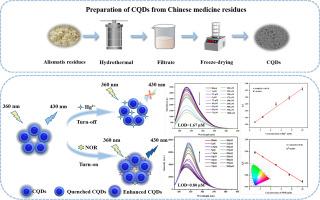环境友好型碳量子点:金属离子和诺氟沙星的开关探针
IF 5.4
3区 化学
Q1 CHEMISTRY, INORGANIC & NUCLEAR
引用次数: 0
摘要
介绍了一种简单、环保的水热合成中草药渣碳量子点的方法,并对其结构和光学特性进行了深入的研究。所制备的CQDs的量子产率(QY)达到62.0%,并具有蓝紫色荧光。它们具有优异的光致发光性能,在水中的溶解度高,分散性好,平均尺寸为3.01 nm。有趣的是,所获得的CQDs可以作为Fe3+/Hg2+的关闭探针和诺氟沙星(NOR)的打开探针。此外,CQDs对Fe3+、Hg2+和NOR的检出限(lod)分别为0.48 μM、1.67 μM和0.80 μM,明显优于之前报道的CQDs,证明了CQDs对水溶液中Fe3+、Hg2+和NOR的检测效果。Fe3+和Hg2+的荧光猝灭主要归因于IFE和PET。相比之下,与NOR相关的荧光增强主要是由于CQDs与NOR之间的氢键相互作用以及配合物的形成。细胞毒性实验表明,在浓度为200 μg/mL时,CQDs的细胞存活率超过85%,表明制备的CQDs具有良好的生物相容性。该方法成功地测定了自来水和河流水样中的Fe3+、Hg2+和NOR,表明cqds探针具有良好的应用前景。本文章由计算机程序翻译,如有差异,请以英文原文为准。

Environmentally friendly carbon quantum dots: A turn-off/turn-on probe for metal ions and norfloxacin
A straightforward and environmentally sustainable hydrothermal synthesis approach is introduced for creating carbon quantum dots (CQDs) from the Chinese herbal medicine (CHM) residue, with thorough studies on their structural and optical characteristics. A considerable quantum yield (QY) of 62.0 % and a blue-violet fluorescence were observed in the prepared CQDs. They possess excellent photoluminescence, high solubility in water, and good dispersibility, averaging 3.01 nm in size. Interestingly, the obtained CQDs can be served as a turn-off probe for Fe3+/Hg2+ as well as a turn-on probe for norfloxacin (NOR). Additionally, the limits of detection (LODs) for Fe3+, Hg2+, and NOR were measured at 0.48 μM, 1.67 μM, and 0.80 μM, respectively, which were markedly superior to those previously reported for CQDs, demonstrating their effectiveness in detecting Fe3+, Hg2+ and NOR in aqueous solutions. The fluorescence quenching of Fe3+ and Hg2+ was primarily attributed to the IFE and PET, respectively. In contrast, the fluorescence enhancement associated with NOR was predominantly due to hydrogen bonding interactions between CQDs and NOR, as well as the formation of complexes. The cytotoxicity assay revealed a cell viability rate exceeding 85 % at a concentration of 200 μg/mL, suggesting that the prepared CQDs have acceptable biocompatibility. This method proved successful in determining Fe3+, Hg2+ and NOR in tap and river water samples, suggesting good application prosperity of the CQDs-based probe.
求助全文
通过发布文献求助,成功后即可免费获取论文全文。
去求助
来源期刊

Inorganic Chemistry Communications
化学-无机化学与核化学
CiteScore
5.50
自引率
7.90%
发文量
1013
审稿时长
53 days
期刊介绍:
Launched in January 1998, Inorganic Chemistry Communications is an international journal dedicated to the rapid publication of short communications in the major areas of inorganic, organometallic and supramolecular chemistry. Topics include synthetic and reaction chemistry, kinetics and mechanisms of reactions, bioinorganic chemistry, photochemistry and the use of metal and organometallic compounds in stoichiometric and catalytic synthesis or organic compounds.
 求助内容:
求助内容: 应助结果提醒方式:
应助结果提醒方式:


